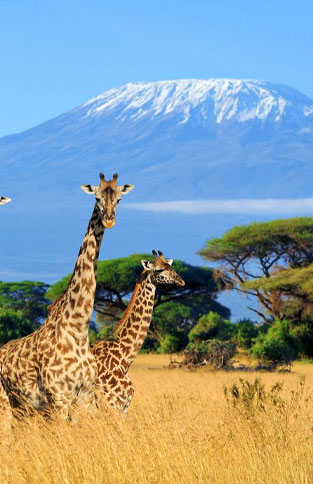 English
English
 English
English
Kilimanjaro National Park is a national park located in northern Tanzania, near the border with Kenya. The park is named after Mount Kilimanjaro, the highest peak in Africa, and covers an area of 1,688 square kilometers (652 square miles).
The park was established in 1973 to protect the unique ecosystem and wildlife of the region, as well as to provide opportunities for visitors to experience the natural beauty of the mountain and the surrounding landscape. The park is home to a diverse range of flora and fauna, including several species of primates, large mammals such as elephants and buffalo, and over 180 species of birds.
The main attraction of the park is Mount Kilimanjaro itself, which can be climbed by experienced hikers and mountaineers. The mountain is made up of three distinct volcanic cones, and is the highest free-standing mountain in the world. The park offers several different routes for climbing the mountain, ranging in difficulty and duration.
In addition to hiking, visitors to the park can also enjoy game drives, guided walks, birdwatching, and cultural tours of the surrounding villages. The park is open year-round, although the best time to visit for hiking is during the dry season from June to October.




Here is a brief overview of the best time to visit Kilimanjaro National Park based on each month:
January and February: These months are generally considered the best time to climb Mount Kilimanjaro, as they offer the most stable weather conditions with clear skies and little rain.
March to May: This is the rainy season, with heavy rainfall and high humidity. The park can be less crowded during this time, and the landscape is lush and green. However, the rain can make hiking and driving conditions more challenging.
June to October: These months are the dry season and the best time for wildlife viewing. The vegetation is less dense, making it easier to spot animals, and the animals tend to congregate around water sources. These months are also considered the best time to climb Kilimanjaro.
November to December: This is the short rainy season, with occasional showers and thunderstorms. The park is less crowded during this time, and the landscape is still green and lush. However, some roads and trails may be closed due to flooding.
1,688 km²
Yes
Northern Tanzania
wildlife viewing, birdwatching, cultural tours.
Activities at Kilimanjaro National Park include climbing Mount Kilimanjaro, wildlife viewing, birdwatching, cultural tours, hiking and trekking, and camping and picnicking.
Visitors can view a range of iconic African wildlife species, including elephants, buffalos, giraffes, zebras, and primates. The park offers a range of landscapes, including waterfalls, forests, and alpine meadows. The park is a popular destination for adventure-seekers and nature lovers alike.
Kilimanjaro National Park is home to a diverse range of wildlife, including large mammals, primates, and birds. Here are some of the most common wildlife species you can expect to see in the park:
Elephants: These majestic animals are a common sight in the lower elevations of the park, particularly around the foothills of Mount Kilimanjaro.
Buffalos: Large herds of buffalos can be seen grazing in the park's grasslands and savannahs.
Giraffes: These graceful animals can be seen wandering the park's woodlands and acacia forests.
Zebras:These striped herbivores are a common sight in the park and can often be seen grazing alongside wildebeests and other herbivores.
Wildebeests: These animals are known for their spectacular annual migration, which takes them through the park between November and June.
Primates: The park is home to several species of primates, including baboons, vervet monkeys, and blue monkeys.
Birds: With over 180 species of birds recorded in the park, it is a birdwatcher's paradise. Some of the most common bird species include the augur buzzard, the African fish eagle, and the crowned crane.
